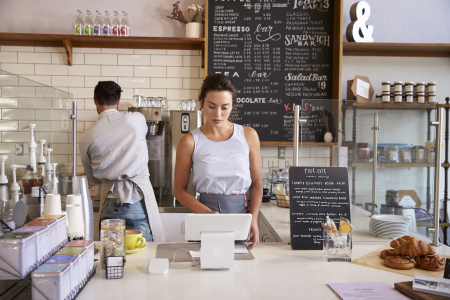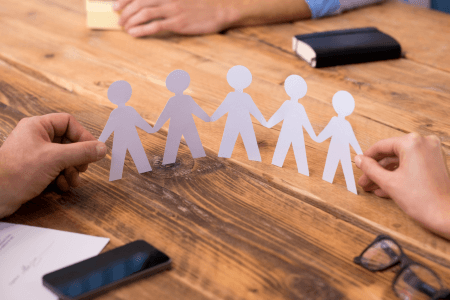We often – and quite rightly – talk about the very real distinctions between B2B and B2C markets, buyers and decisions. However, the traditional paradigm of ‘B2B as rational’ and ‘B2C as emotional’ is being challenged by an increasingly strong undercurrent of discussion about the thoughts, feelings and emotions of B2B buyers and decision makers as individuals – not just as representatives of the corporations they work for. In one of our blogs last month, Georgia Wadsworth discussed this very issue, highlighting how important it is for a business to be ‘humanly relevant’ and appeal to the emotions of those making business decisions.
A B2B buyer is not solely an agent of the business they work for, and they do not exist in a vacuum. They are a human being with emotions, preferences, and a life that exists outside of their workplace. And, outside of work, they are a consumer. It is inevitable that our expectations as B2B buyers are shaped, to some degree, by our experiences as consumers in the B2C world. Therefore, in addition to the space that is being carved out for the ‘human’ in B2B decision making, much can be gained by recognising the ‘consumer’ as an additional influence.
The consumer, as I’m sure we can all recognise, is faced with an overwhelming choice of products and services; able to order for next day delivery, at the click of a button; familiar with the ‘personalities’ of our favourite brands through prolific social media presence. These three elements of the consumer experience – access to a wider than ever range of options, ability to quickly and easily acquire products, and exposure to a strong social media presence – are all relatively recent phenomena, but have become so prevalent that many of us can’t imagine our daily lives and purchasing experiences in any other way. As the bar has been continually raised by B2C companies in terms of the choice, access and exposure they offer – so too have our expectations as consumers risen exponentially. For many of us, these high expectations will be translated into our lives at work, influencing our expectations as buyers in a B2B context.

In her article ‘Too Much Choice’, Eva Krockow uses the example of a coffee shop to illustrate the overwhelming amount of choice available to consumers – Starbucks, she says, offers a choice of 80,000 different drinks combinations. Disadvantages of such abundant options aside (decision paralysis, disappointment or self blame) freedom of choice and maximum product variety is still very much expected by consumers, due to the liberal belief that making our own decisions will lead to increased happiness and wellbeing. Taking into account the aforementioned importance of emotions in B2B buying, it makes sense that the same underlying motivation and desire for variety also applies here – particularly when buyers are used to this desire being met when they are operating as consumers, outside of work.
Furthermore, in the consumer sphere, potential stress caused by an overload of choice is partially tackled through the use of numerous comparison and review services – usually websites – to aid the consumer in making a choice. These decision making aids are not always so readily available in B2B markets – mostly because, by definition, the target audience for products and services is much smaller. One particular area where we have noticed this in our own research is in the utilities sector. While it is very easy for consumers to compare a range of utilities offers from different suppliers on one web page, this is not always an option that is widely available to businesses. The utilities being sold are the same as in the consumer space, the suppliers are often the same, and B2B buyers are used to quick and easy comparison in their lives as consumers – it can therefore be disappointing when the expectations they have built up as consumers are not lived up to in their work interactions. The disconnect between the B2C experience and the B2B experience is apparent.
The second element of the consumer experience that will influence expectations in the B2B space is the ability to quickly and easily acquire products, which is increasingly done online. In consumer retail, online sales have soared in recent years. In the UK, online sales of non-food items made up almost a quarter of the total market in 2017. Ed Bowsher of the Financial Times suggests that convenience – including next day, or even same day, delivery – is the most important reason behind the rise in online sales. While experts tend to believe that physical shops will continue, the decline of the high street is difficult to ignore – in the first nine months of 2018, 1,000 retail businesses went into administration and 85,000 retail jobs disappeared from Britain’s high streets.
B2B online sales are also on the rise, and are predicted to reach over $6.6 trillion globally by 2020. However, as Brian Beck argued last year in an article for Digital Doughnut, many B2B companies remain at least ten years behind where they should be in terms of digital transformation. While it’s true that running a B2B ecommerce channel is often more complex than for B2C – due to B2B’s higher value sales, wider range of payment methods, and complicated catalogues – B2B customers increasingly expect to be able to buy the products they need through multiple online channels, and for those products to be delivered more quickly than they ever have been before – just as they do in their lives as consumers. However, websites of B2B companies are often digital catalogues, containing product information but lacking the ability to actually make the purchase online. Tracey Wallace of Big Commerce identifies features of successful B2B ecommerce websites – including showing prices to signed-in customers who have individually negotiated terms, inclusion of a 24/7 online chat feature, and the ability for customers to save a custom order in order to easily repurchase it. Features like this allow the B2B buyer to replicate their quick and easy consumer experience when purchasing for their business, while the additional needs and challenges of B2B ecommerce are still accommodated.
There has been a significant amount of commentary about the use of social media in B2B marketing, with a growing consensus that these channels do have a place within the strategies of B2B brands. There are numerous examples of B2C brands with successful social media strategies – one being the baking brand Greggs which has become known for its humorous Twitter feed, most recently handling the backlash to its newly-introduced vegan sausage roll. But, as Hannah Landers of Woden argues, it can be difficult for B2B companies to see a place for themselves in this playful landscape. Outside of LinkedIn, which is focussed specifically on business, many B2B companies have a relatively low social media profile. However, and especially considering the increased importance given to establishing emotional connections with B2B buyers, social media is important as it offers a forum for B2B companies to connect more closely and authentically with their target market. Examples of successful B2B social media campaigns identified by Aseem Badsha of Socedo include MarketStar’s ‘The Evolution of the “Zombie” Lead’, which uses graphics and storytelling to engage its Twitter followers. Storytelling on social media is one strategy allowing B2B brands to maintain their professional image, while engaging followers with interesting content that reflects the brand’s personality. The use of engaging visual content, particularly on image-based channels like Instagram, can also be very effective for B2B brands.
The differences between B2C and B2B markets will always be important, but there is much to be gained from considering the similarities. All B2B decision makers have a not-so-secret double life as a consumer, and it is inevitable that experiences enjoyed in the B2C world will shape expectations of what can be achieved in a B2B context.
Further Reading
https://www.theguardian.com/business/2018/nov/11/jobs-lost-retailers-high-street-decline
https://www.netsolutions.com/insights/b2b-ecommerce-2018-infographic/
https://www.meltwater.com/uk/blog/best-b2b-instagram-profiles/




